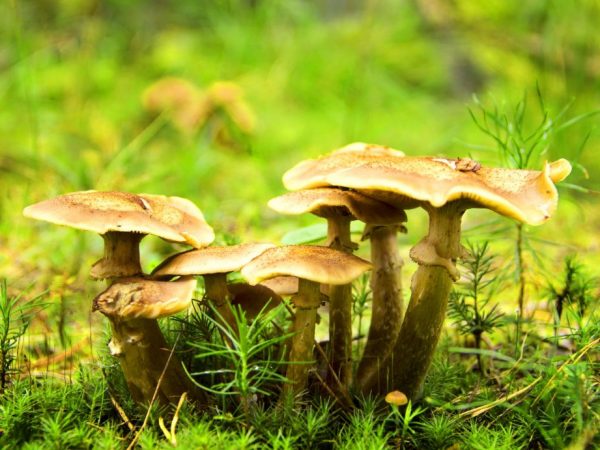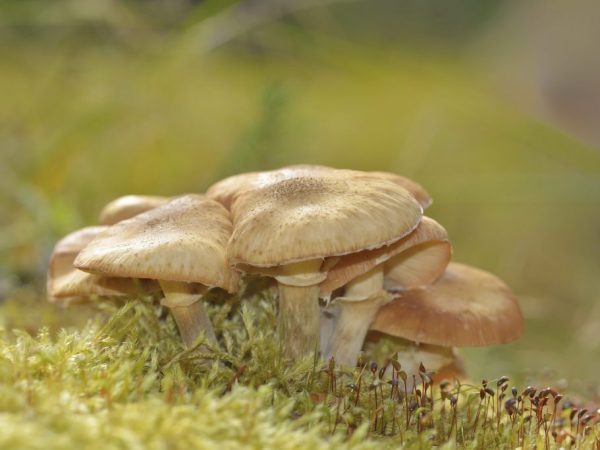Features of meadow mushroom
Meadow honey agaric grows in open areas, in the grass: in glades, lawns, pastures, roadsides, in gardens. This habitat somehow does not fit with the name "mushroom". You can meet him from late spring to mid-autumn. Its other names are marasmius meadow, meadow nonnium, clove mushroom, meadow. It tolerates drought well, bears fruit abundantly. It grows in rows or arcs, forming "witch circles".

Features of meadow mushroom
Description of the appearance of the mushroom
The hat is yellow-brown or reddish-red, in dry weather - light cream, 2-5 cm (less often - 8 cm) in diameter. The surface is smooth. In young honey agarics it has the shape of a hemisphere, convex. Over time, it becomes flat, spread out. There is a tubercle in the center. The edges are translucent, often uneven, ribbed. The center of the cap is dark. In wet weather conditions, the cap is sticky. It is characterized by the phenomenon of hygrophilousness.
Irina Selyutina (Biologist):
Hygrophilousness - the ability of the pulp of the caps of some types of mushrooms to swell under the influence of moisture falling on its surface. The false tissue (trama) forming the pulp is represented by a loose, rather than dense weave of hyphae, as a result of which spaces arise between them in which water is retained. Therefore, depending on weather conditions, hygrophilous caps are able to change their color, and when dry, concentric zones appear, which begin to spread either from the center to the paradise of the cap or vice versa.
The pulp is thin, white or light yellow in color with a slight sweetish taste (due to the trehalose content) and a specific smell reminiscent of the smell of cloves, hence the name "clove mushroom" or bitter almond.
The plates in young honey agarics are adherent, in mature ones - free. Their width is 3-6 mm. The location is rare. Spores are ovoid or elliptical, smooth.
According to the description, the leg is high (up to 10 cm) and thin (2-5 mm). Slightly thickened at the base, sometimes curved. Dense, tough in older specimens. She has the same color as the hat.
The mushroom is edible, it belongs to the 4th category.
Twin mushrooms
Meadow mushrooms have mushrooms similar in appearance and taste. Not all of them are edible, so you need to be able to distinguish between different types. Doubles include:
- Kollybia les-loving (spring honey agaric, forest meadow honey agaric): grows in mixed forests on trees, stumps or under leaves. The leg is not long - up to 6 cm, tubular, hollow. The cap is often whitish. The plates are more frequent, white or ocher-cream. The mushroom has an unpleasant, pungent odor. It is classified as conditionally edible.
- Whitish talker: curved hat, always white. The tubercle in the center is absent. Leg height - up to 4 cm. Attention! Representatives of this species grow in the same places as non-nippers. Forms "witch circles". This mushroom is poisonous.
- Honey mushrooms are autumn, winter and summer: grow on stumps, rotting wood. Outwardly they look like marasmius. Among these species, there are also poisonous ones, for example, false honey.
Useful properties and contraindications
The composition of the product determines its benefits for the human body. Meadow mushrooms contain the following substances:
- proteins;
- fats;
- carbohydrates;
- antibiotics;
- polysaccharides;
- trace elements: copper, zinc, etc.
Their regular use has the following effect:
- enhances immunity;
- improves performance;
- lowers blood pressure;
- normalizes metabolism;
- removes cholesterol;
- calms the nervous system;
- has a beneficial effect on blood circulation.

Eating mushrooms boosts immunity
Mushrooms have a laxative effect. They will not cause much harm if they are not abused. Children under 7 years old are not recommended to give mushrooms at all due to the physiological immaturity of the body (specific enzymes are not yet produced). Contraindications are serious bowel and stomach diseases.
Application
After the mushrooms are harvested, they begin to darken quickly, so you should clean them right away. To do this, marasmius are first sorted out, removing low-quality ones (with rot and mold). Then they wash thoroughly.
In cooking
For food, hats are more often used. The legs, especially in older specimens, are tough - they are removed, but they are quite suitable for preparing mushroom caviar or powder. They are prepared in different ways: fried, boiled, pickled and salted.
The marasmius broth is superior in taste to the broths prepared even from porcini mushrooms. Soups, sauces, main courses are prepared from them, they are added to pates, casseroles. If the field mushrooms are dried, then they should not be washed. They are carefully cleaned with a knife from debris, bugs. These mushrooms are also suitable for freezing.
In medicine
Nebnichnik contains marasmic acid and scorodonin. These substances are potent against disease-causing bacteria, including Staphylococcus aureus, which causes a variety of diseases. Resist viruses.
The polysaccharides secreted by the mycelium put the thyroid gland in order. Lecithin contained in honey ages is used in kidney diseases, since it is able to destroy thrombofibrins and platelets, which are associated with kidney microangiopathy. Phytohemagglutinins are used to determine the blood group. This is the best option because usually for such purposes take human serum. Also, marasmius has the property of suppressing the development of cancer cells.
Irina Selyutina (Biologist):
One of the properties of the non-pot is its ability to suppress the phenomenon of apoptosis. Apoptosis is a specific, regulated process, the process of cell death programmed in DNA, in which its contents, the protoplast, breaks down into individual particles - apoptotic bodies, limited by the plasma membrane. In about 90 minutes, they are all absorbed by macrophages in the process of phagocytosis or by neighboring cells, and the development of the inflammatory process does not occur. It is believed that apoptosis is designed to destroy defective cells.
In China, meadow mushrooms are used in folk medicine. They act as an anticonvulsant. With the help of non-nippers, they get rid of pain in the legs, treat tendons and veins, and relax muscles.
Growing methods
Meadow mushroom is best grown in the shaded parts of the site: under trees, bushes, in the beds. The soil is loosened, the weeds are not removed. Sow mycelium. This is done during the fruiting period of marasmius. More suitable timing for manipulation is as follows:
- September-early December;
- end of February-May.
Consumption: 1 package (100-150 g) for 2.5-3 m2... Humus or compost is laid on the garden bed in a layer of 5-10 cm. The first crop is harvested in 2-2.5 months.
By the way. From 1 m2 get up to 6 kg of meadows per month.
Planting does not require insulation for the cold season, because the mycelium tolerates low temperatures well. At the end of autumn, when fruiting stops, the mycelium is fertilized. Pour humus (humus) or dried plant residues on top.Feeding substances are also combined. Planting in one place will last 4-6 years.
It is possible to collect marasmius all year round. For this, the mycelium is sown in garages, sheds, basements and other premises. The temperature regime is different - from + 5 ° С to + 30 ° С. Cultivation is carried out in boxes, plastic bags. The earth is watered from a watering can. Vessels with water are placed near containers with mycelium. Such a mycelium gives a good harvest, but with each season it will decrease the indicators.
Conclusion
Meadow mushrooms are saprophytic fungi that grow on nutritious soil, feeding on decaying residues of plant or animal origin. They tend to renew after drying, when water comes to them again. Then they start producing spores. The downside of this species is susceptibility to parasite infestation.
Collect non-nippers in different countries of Eurasia, in Iceland, Japan, Africa, America. They are delicious and healthy. Our ancestors believed that if girls wash themselves with morning dew from marasmius, then the skin takes on a healthy, well-groomed appearance.


